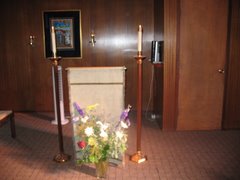Thanks for your question! Yes!!!! You are exactly right that the video and especially the reference to the Desert Abbas' apothegm crystallizes the value of stability in monastic life. Though I have heard some misunderstand the meaning of stability when used in this regard, it does not refer to emotional stability, or "stabilizing one's emotions." Instead, it refers to the practice of monastics to make profession in one monastery and commit to staying there for the rest of one's life unless one is sent to help found another monastic house.
The fundamental spiritual insight into this value is rooted in the recognition that while one remains in the same place or continues the same basic rhythm and patterns of behavior (horarium) day in and day out, one will go deeper and deeper in one's relation to one's true self and one's relationship with God. Those who profess (or otherwise practice) monastic stability are convinced that everything they truly need is found here in this monastery. The monk binds himself to this faith community and to learning to love in concrete ways, to forgive oneself and one's confreres both often and completely, and to allow himself to be shaped by his brothers' needs and concerns just as Christ did. When coupled with the other vows and values of monastic life, the monk or hermit is led more and more to attend to God as the one reality necessary for the fulfillment of every dimension of a truly human life --- every relationship, every aspiration, everything one is and does.
A hermit practicing this form of stability in her hermitage can go a couple of different ways. The first is not the way the hermit is meant to go, but it can happen without competent spiritual direction and appropriate initial and ongoing formation. This is the way of self-centeredness and dissipation. In the search for God (seeking God), one can find oneself unable to focus and turn to book after book after book (for instance) without going particularly deep into any of them. Bishop Varden speaks about this in his series on the Desert Abbas. When the monk treats the monastery library (or the books in one's cell or hermitage) as a kind of casual buffet and nibbles at every author, every Church Father, or Doctor of the Church, but truly fails to drink deeply from or be profoundly fed (much less inspired, challenged, and changed) by any of them, he is betraying or failing in his commitment to stability -- among other things.Similarly, someone whose eremitical life is inauthentic can focus on this external fault or flaw and then another one and then another one, without ever truly seeking the reason for the fault or flaw that resides much deeper within the person. It is possible to "paper over" one's deep woundedness or illness with confessions of one's more superficial faults and then celebrate God's (unfortunately) equally superficial forgiveness when, instead, authentic eremitical life calls us to a much deeper engagement with both our own brokenness or woundedness and the grace of God. What is sometimes missing, then, is a deep engagement with or resulting understanding of the texts themselves, their still-unfamiliar authors, or the God the texts sought to consider, put one in touch with, and celebrate. This kind of superficially engaged approach to monastic or eremitic life is a form of dilettantism antithetical to monastic life and its commitment to stability.
The second way a monastic or hermit embracing stability can go within their monastery or hermitage is deeper, ever-deeper. While one is apt to read widely as a monastic or hermit, one is also apt to become very well-read and relatively expert in a particular period of history, specific authors, certain topics, etc. In my own life I can look at several topics that have interested me for decades now: chronic illness as vocation and sometimes as eremitical vocation, the redemption of isolation which we then recognize as "the silence of solitude," c 603 as an ecclesial vocation, the discernment and formation of such vocations, and the Theology of the Cross and God's will to be Emmanuel -- God With Us. These are related topics (the last two function as keys to or even "keystones" in this relatedness), and each tends to call for and lead, at least indirectly, to greater depth of understanding in the others. Even more importantly, however, they are significant signposts of my own inner journey and the nourishment and theological content I have needed in order to go deep -- through and beyond my own woundedness, to the God of Life who dwells in that paradoxical place of existential loneliness and betrothal. Thus, when I am occasionally criticized for continuing to spend time writing here about c 603 as though I am "unspiritual", too "coldly intellectual," and "obsessed with law" rather than gospel, for example, it hardly matters!One of the reasons I insist on the need for hermits (including very experienced hermits) to work regularly with a competent spiritual director is precisely to prevent one's eremitical life from assuming the first pattern as things get difficult, or tedious, or even apparently absurd -- and when things are sailing along and looking fine as well! When darkness obscures the path, when God is silent (as God mostly is!), when suffering kicks up clouds of doubt and tempts to despair, or when none of these things are happening and all goes well, working with a director can help one to stay the course and go deeper. A good director can also ask the questions needed or suggest the journaling and Scripture reading (etc.) that will help to get us back on our path when we have stepped off course or seem to have stalled in our journey.
Conversations with such persons can help us express both the darkness and light we experience, articulate the struggles we must negotiate, and share the failures and successes that mark and move us from faith to faith. Similarly, they can help us learn to listen to both ourselves and God in ways that will allow our journey to continue toward genuine wholeness and holiness. This kind of ongoing reflection, encouragement, and wisdom is critical in such a perilous and significant undertaking. It is indispensable for eremitic stability and thus, for a life that is not to be wasted in some form of self-centered dilettantism. Remaining in one's cell can, unfortunately, mean learning nothing and failing to grow as a truly loving person (a danger for every hermit), while pretending both to oneself and others to be living a demanding, authentic eremitical life. On the other hand, it can introduce us to the encounter and engagement with existential solitude so essential to our humanity and to learning everything "the cell" (stability) has to teach us.















































